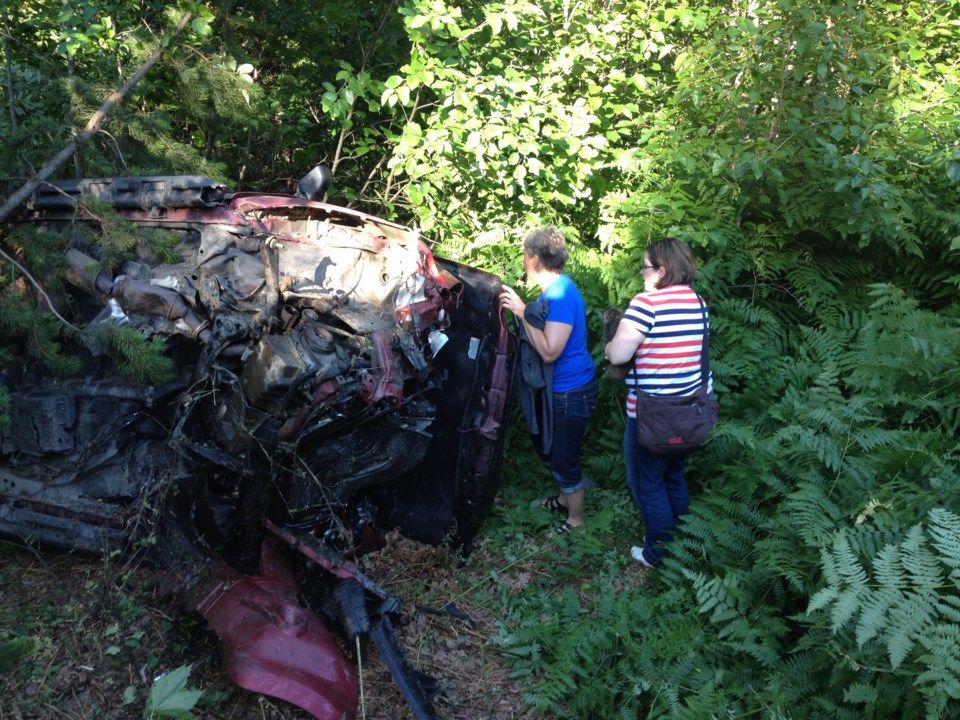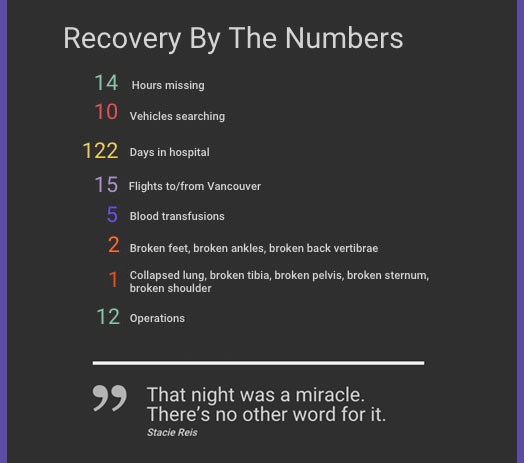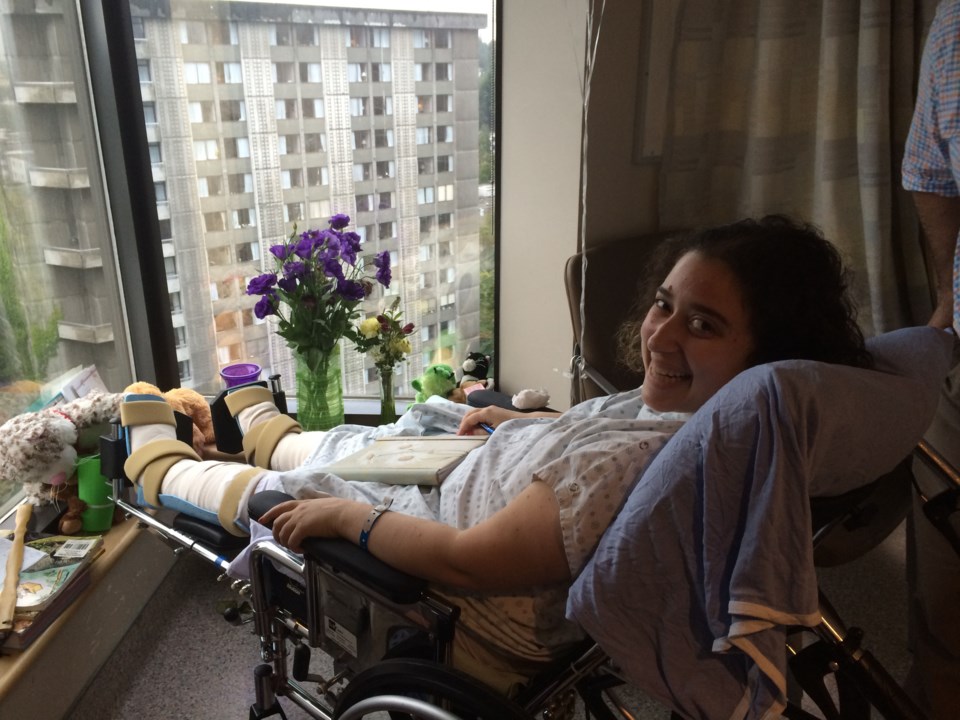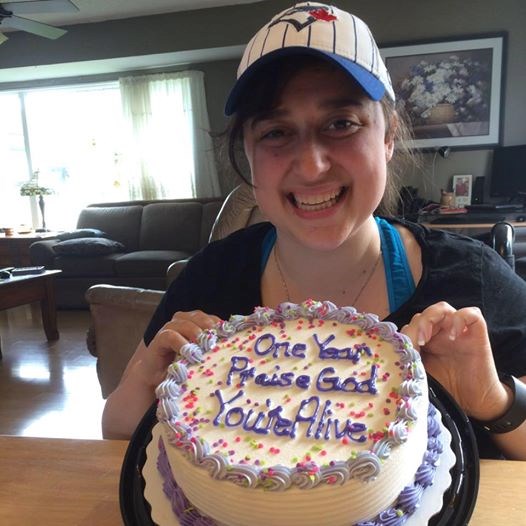A year after Stacie Reis survived a catastrophic crash, she stood with her family in Kitimat, released a pink balloon and watched it join the dozen others floating skyward as a symbol of her grandfather in heaven.
She'd been driving from Prince George to see him one last time when her car tumbled down a 40-foot embankment last July.
During his funeral, she was hundreds of kilometres away, recovering in a Vancouver hospital bed from a host of broken bones: ankle, tibia, pelvis, sternum, shoulder, ribs, back vertebrae. But last week, the 28-year-old was with family celebrating the one-year anniversary of his passing and her survival.
"Considering he was most known for his legacy of being a storyteller, it seems completely fitting that that journey would become an epic story in itself," Reis wrote on Facebook, before posting her image beaming with an ice cream cake - her "Yay... I didn't die" cake.
The last year in recovery has been its own epic story:
Five blood transfusions.
One bone graft.
Two ankle fusions.
Twelve operations.

By late August, the Prince George nurse had been transferred home to Kitimat and her story had gone global for her quick-thinking efforts to straighten her legs, keeping the blood flowing during the 14 hours she was missing and ultimately saving them.
By October, the story looked like it might lose its happy ending.
The bone fusion on her right ankle went badly.
Immediately after the surgery, she got a "brutal bone infection," which set her back about six months. It also raised the spectre of amputation again.
An emergency surgery in the middle of the night six days later reversed that work. A surgeon took out the metal meant to strengthen her ankle and drained her foot that had ballooned to almost double its size.
"When the accident first happened, it was very surreal. I was too busy to get depressed," Reis said.
"There were all these different healing steps. It was always going forward."
But this was a huge setback, and it still marks the hardest moment over the last long year.
"It was pretty exhausting," said Reis, recalling the six weeks of IV therapy, three times a day.
"I'm still not walking on my left foot, which is disappointing. I was hoping I'd be little farther than I am now."
By December, she could put weight on the left leg. For the last seven months, she's shuffled on her walker or hopped around on the one leg. Gaining some independence from the wheelchair was a positive step for her mental health.
"It started to make it feel more normal, my life is still different but I'm still living my life," she said. "Once I started walking I think my mentality changed a little bit towards 'I have my disability, and I have my challenges, but I'm not sick anymore.'"

Reis is hopeful. Although the infection can lie dormant in her foot for up to a decade, she feels good. The second attempt at the ankle fusion last month was successful. It looks like she'll have the green light to walk on her right foot in about a month, and doctors say if she works hard she can eventually get back to the 12-hour days expected of nurses.
She wants to return to her work at the Neonatal Intensive Care Unit, where she can't wait to achieve milestones with her patients.
"I love getting to bond with patients and help them overcome their obstacles which I feel like going back I'll have an even more unique way to do that," said Reis.
"I think nursing is so much of who I am."
That nursing knowledge - aside from giving her the ability to save her own legs - has helped her come to terms with the long path ahead.
"Even though it sometimes seems like it's been so long, it's been a year. It's not been that long. On the scheme of traumas - even the nurse in me knows that - on the spectrum of what I've been through, a year is not that long. Maybe that's where my nursing knowledge has helped me. Just because I'm not walking doesn't mean I won't get there."

Since the day of the crash, she and her family and friends have documented the progress in a journal and the little moments that brightened her days:
July, 7 2015: Three days after the accident, her father left the room as doctors pulled tubes from her throat. "When he came back the tube was gone and I looked at him and I mumbled something and as he got closer, I pointed at my chest and I whispered that it was heavy. But he was ecstatic because I was talking and that was the first time I spoke since the accident."
July 23, 2015. Friends brought fresh baked croissants and washed her hair and spoke with her about her Grandpa.
"It was the first time in awhile that I told the story from start to finish and it gave me more energy.... I worked really hard in physio and I started wiggling towards the chair. I was in a little more pain and discomfort and I got a little tuckered out... It was a good day."
August 10, 2015. A friend wrote a favourite Stacie quote: "Turns out kind of dying kinda sucks sometimes."
May 27, 2016. Days before her second ankle fusion, 2:30 a.m. "So apparently I'm a hot mess tonight. It started with thinking about my upcoming surgery. I decided to try and Google, which is never a good idea... Here I am bawling over my future, the pain I may experience and the challenge it's going to be to get back to work. I'm grieving like I haven't done in months."
June 2, 2016. Her final entry in the journal, after her successful surgery.
"The pain has not been half of what I expected and I was off IV meds by the end of the night."
Those first entries betray the shake in her fingers but by the end Reis can see the contrast between her fears for her foot and the final entry where they are dispelled.
"The whole medical drama, it's pretty much contained in that one journal," Reis said.
She's closed that book, that chapter of her life, and she's noticed her new journal reflects the regularity of a normal day-to-day, with "classic girly stuff."
The act of writing and speaking her reality - her fears, her pain, her progress - has offered its own healing.
"I have challenges and I have struggles but I'm not traumatized. I think a lot of that was right from the get-go I told them all about it and I was really able to process it in a fairly healthy way," she said.
Her faith got her through that night on July 4, 2015 when she prayed as she set her legs and it's been a source of comfort since.
"I don't know how people who don't have a faith get through those challenges but for me I know that's how I get through them, is relying on a strength that is bigger than me," said Reis, who feels the accident has brought her closer to Christ. "If you don't have struggles, if you don't have challenges that you need to overcome, you don't really see strength God provides you."
Even as the crash wracked her body and put her life on hold, Reis can see how she's benefited: more time for friends and family; better knitting skills; time to relax by reading or watching Netflix; a new-found love of the Toronto Blue Jays; the ability to learn a new language.
"When I look back and reflect on the last year I'm not sad, I'm not disappointed," she said. "I love my job but I sometimes took on more shifts than I should've and I didn't do really great self care."
And Reis feels like she's witnessed a miracle.
"There's no other word for it and the fact that I got to experience that. There's lots of people who go through life and don't get to experience a miracle like that. I think I'm lucky, especially as I get better... I think that I'm lucky to have gotten through it."




